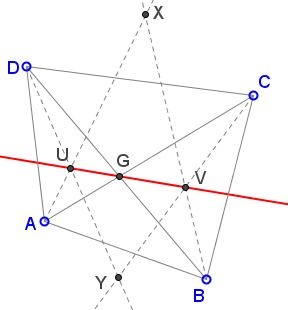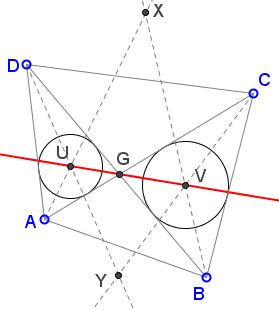Angle Bisectors in a Quadrilateral
Cyclic and Otherwise
What is this about?
A Mathematical Droodle
|Activities| |Contact| |Front page| |Contents| |Geometry|
Copyright © 1996-2018 Alexander Bogomolny
The applet attempts to suggest the following problem:
In quadrilateral ABCD, define X as the intersection of bisectors of angles CAD and CBD, and Y as the intersection of the bisectors of angles ACB and ADB. Also, let U, V, G be the intersections of AX,DY; BX,CY; AC,BD, respectively.

Prove that
- U, G, V are collinear.
- If ABCD is cyclic then X and Y lie on its circumcircle.
(The problem is rather straightforward. It's an attempt to salvage time spent on verifying the faulty formulation of an olympiad problem that appears online. This is problem #10.2 from the 1994-1995 Regional St Petersburg Mathematical Olympiad. The formulation as it stands is definitely wrong.)
U and V are the incenters of triangles ADG and BCG, such that GU and GV are their third angles bisectors. GU and GV bisect two vertical angles and therefore form a straight line.

When ABCD is cyclic, the bisector of ∠CAD meets the circumcircle of ABCD the second time at the midpoint of arc CD. The same holds for the bisector of ∠CBD. Thus the two intersect (at point X) on the circumcircle. Point Y is treated similarly.
It is possible to formulate a less trivial problem by making away with the requirement of the cyclicity of the quadrilateral:
In quadrilateral ABCD, define X as the intersection of bisectors of angles CAD and CBD, and Y as the intersection of the bisectors of angles ACB and ADB. Then, if X lies on the circumcircle of ΔBCD, then so does Y.
For a proof, observe that X lies on the circumcircle of ΔBCD iff A lies on that circle. Indeed, let C(BCD) and C(ACD) be the circumcircles of triangles BCD and ACD respectively. The bisector of ∠BCD meets C(BCD) in, say, X', and that of ∠ACD meets C(ACD) in X''. The two points coincide iff they both lie on the circumcircle of triangle X'(X'')CD. Which means that
But this makes the quadrilateral ABCD cyclic and we may now reuse the previous result.
|Activities| |Contact| |Front page| |Contents| |Geometry|
Copyright © 1996-2018 Alexander Bogomolny
71529542
